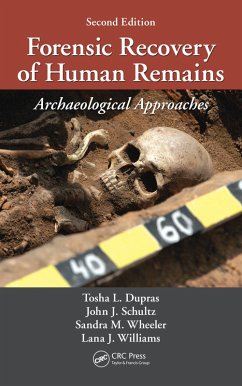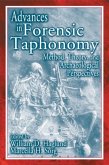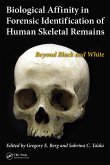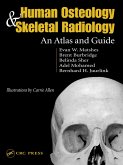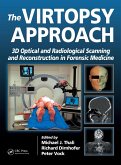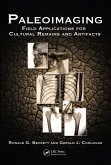John J. Schultz, Lana J Williams
Forensic Recovery of Human Remains (eBook, PDF)
Archaeological Approaches, Second Edition
58,95 €
58,95 €
inkl. MwSt.
Sofort per Download lieferbar

29 °P sammeln
58,95 €
Als Download kaufen

58,95 €
inkl. MwSt.
Sofort per Download lieferbar

29 °P sammeln
Jetzt verschenken
Alle Infos zum eBook verschenken
58,95 €
inkl. MwSt.
Sofort per Download lieferbar
Alle Infos zum eBook verschenken

29 °P sammeln
John J. Schultz, Lana J Williams
Forensic Recovery of Human Remains (eBook, PDF)
Archaeological Approaches, Second Edition
- Format: PDF
- Merkliste
- Auf die Merkliste
- Bewerten Bewerten
- Teilen
- Produkt teilen
- Produkterinnerung
- Produkterinnerung

Bitte loggen Sie sich zunächst in Ihr Kundenkonto ein oder registrieren Sie sich bei
bücher.de, um das eBook-Abo tolino select nutzen zu können.
Hier können Sie sich einloggen
Hier können Sie sich einloggen
Sie sind bereits eingeloggt. Klicken Sie auf 2. tolino select Abo, um fortzufahren.

Bitte loggen Sie sich zunächst in Ihr Kundenkonto ein oder registrieren Sie sich bei bücher.de, um das eBook-Abo tolino select nutzen zu können.
This reference, now in its second edition, is a comprehensive guide that focuses on the practical aspects of excavating and recovering human remains, as well as any associated evidence, from crime scenes. It highlights the protocols and techniques that are used to successfully survey, map, recover, document, collect, and transport evidence. New add
- Geräte: PC
- mit Kopierschutz
- eBook Hilfe
- Größe: 51.22MB
Andere Kunden interessierten sich auch für
![The Use of Forensic Anthropology (eBook, PDF) The Use of Forensic Anthropology (eBook, PDF)]() Robert B. PickeringThe Use of Forensic Anthropology (eBook, PDF)142,95 €
Robert B. PickeringThe Use of Forensic Anthropology (eBook, PDF)142,95 €![The Routledge Handbook of Archaeological Human Remains and Legislation (eBook, PDF) The Routledge Handbook of Archaeological Human Remains and Legislation (eBook, PDF)]() The Routledge Handbook of Archaeological Human Remains and Legislation (eBook, PDF)63,95 €
The Routledge Handbook of Archaeological Human Remains and Legislation (eBook, PDF)63,95 €![Advances in Forensic Taphonomy (eBook, PDF) Advances in Forensic Taphonomy (eBook, PDF)]() Advances in Forensic Taphonomy (eBook, PDF)59,95 €
Advances in Forensic Taphonomy (eBook, PDF)59,95 €![Biological Affinity in Forensic Identification of Human Skeletal Remains (eBook, PDF) Biological Affinity in Forensic Identification of Human Skeletal Remains (eBook, PDF)]() Biological Affinity in Forensic Identification of Human Skeletal Remains (eBook, PDF)73,95 €
Biological Affinity in Forensic Identification of Human Skeletal Remains (eBook, PDF)73,95 €![Human Osteology and Skeletal Radiology (eBook, PDF) Human Osteology and Skeletal Radiology (eBook, PDF)]() Evan W. MatshesHuman Osteology and Skeletal Radiology (eBook, PDF)172,95 €
Evan W. MatshesHuman Osteology and Skeletal Radiology (eBook, PDF)172,95 €![The Virtopsy Approach (eBook, PDF) The Virtopsy Approach (eBook, PDF)]() The Virtopsy Approach (eBook, PDF)93,95 €
The Virtopsy Approach (eBook, PDF)93,95 €![Paleoimaging (eBook, PDF) Paleoimaging (eBook, PDF)]() Ronald G. BeckettPaleoimaging (eBook, PDF)172,95 €
Ronald G. BeckettPaleoimaging (eBook, PDF)172,95 €-
-
-
This reference, now in its second edition, is a comprehensive guide that focuses on the practical aspects of excavating and recovering human remains, as well as any associated evidence, from crime scenes. It highlights the protocols and techniques that are used to successfully survey, map, recover, document, collect, and transport evidence. New add
Dieser Download kann aus rechtlichen Gründen nur mit Rechnungsadresse in A, B, BG, CY, CZ, D, DK, EW, E, FIN, F, GR, HR, H, IRL, I, LT, L, LR, M, NL, PL, P, R, S, SLO, SK ausgeliefert werden.
Produktdetails
- Produktdetails
- Verlag: Taylor & Francis eBooks
- Seitenzahl: 398
- Erscheinungstermin: 27. Oktober 2011
- Englisch
- ISBN-13: 9781439850312
- Artikelnr.: 38303205
- Verlag: Taylor & Francis eBooks
- Seitenzahl: 398
- Erscheinungstermin: 27. Oktober 2011
- Englisch
- ISBN-13: 9781439850312
- Artikelnr.: 38303205
- Herstellerkennzeichnung Die Herstellerinformationen sind derzeit nicht verfügbar.
Tosha L. Dupras, Ph.D. specializes in bioarchaeology, particularly diet reconstruction through chemical analysis, and has been associated with the Dakhleh Oasis and Dayr al Barsha projects in Egypt where she has excavated in several cemeteries and analyzed many skeletal remains. Dupras also assists local law enforcement agencies with the search for and excavation of human remains.
John J. Schultz, Ph.D.'s
primary research focuses on forensic and archaeological applications of ground-penetrating radar (GPR) for grave detection, and detection of buried metallic weapons using various geophysical technologies. Schultz is also a consulting forensic anthropologist in the central Florida area for various law enforcement agencies and the local Medical Examiner's Office.
Sandra M. Wheeler, Ph.D.
specializes in bioarchaeology, paleopathology, juvenile osteology, and mortuary archaeology. Wheeler has conducted fieldwork in Belize and Mexico and continues to actively work with the Dakhleh Oasis Project, Egypt. She has assisted law enforcement in Florida and Canada with the search for and recovery of human remains.
Lana J. Williams, Ph.D.
specializes in biochemical analysis of human remains, mortuary archaeology, and human osteology. Williams has conducted fieldwork in Greece and Belize and is currently working with the Dakhleh Oasis and Dayr al Barsha projects in Egypt. In addition, she has assisted law enforcement in Florida and Canada in the search, recovery, and analysis of human remains.
John J. Schultz, Ph.D.'s
primary research focuses on forensic and archaeological applications of ground-penetrating radar (GPR) for grave detection, and detection of buried metallic weapons using various geophysical technologies. Schultz is also a consulting forensic anthropologist in the central Florida area for various law enforcement agencies and the local Medical Examiner's Office.
Sandra M. Wheeler, Ph.D.
specializes in bioarchaeology, paleopathology, juvenile osteology, and mortuary archaeology. Wheeler has conducted fieldwork in Belize and Mexico and continues to actively work with the Dakhleh Oasis Project, Egypt. She has assisted law enforcement in Florida and Canada with the search for and recovery of human remains.
Lana J. Williams, Ph.D.
specializes in biochemical analysis of human remains, mortuary archaeology, and human osteology. Williams has conducted fieldwork in Greece and Belize and is currently working with the Dakhleh Oasis and Dayr al Barsha projects in Egypt. In addition, she has assisted law enforcement in Florida and Canada in the search, recovery, and analysis of human remains.
Introduction to Forensic Archaeology. Tools and Equipment. Human Skeletal
Terminology. Understanding the Forensic Context. Search Techniques for
Locating Human Remains. Methods of Geophysical Survey. Surveying and
Mapping Methods. Applying Archaeological Methods in a Forensic Context.
Collecting Botanical and Entomological Evidence. Collecting Skeletal
Remains. Writing the Final Report. Appendix A: Adult Skeletal Inventory
Form (Field Collection). Appendix B: Infant Skeletal Inventory Form (Field
Collection). Appendix C: Child Skeletal Inventory Form (Field Collection).
Appendix D: Personnel and Scene Summary Form. Appendix E: Recovery Scene
Context Form. Appendix F: Surface Deposit Recovery Form. Appendix G:
Feature Excavation Form. Appendix H: Remains Summary Form. Appendix I:
Forensic Entomology Data Collection Form. Appendix J: Photography/Video
Record Form. Appendix K: Evidentiary Inventory Form. Appendix L:
Evidentiary Chain of Custody Form. Glossary. Index.
Terminology. Understanding the Forensic Context. Search Techniques for
Locating Human Remains. Methods of Geophysical Survey. Surveying and
Mapping Methods. Applying Archaeological Methods in a Forensic Context.
Collecting Botanical and Entomological Evidence. Collecting Skeletal
Remains. Writing the Final Report. Appendix A: Adult Skeletal Inventory
Form (Field Collection). Appendix B: Infant Skeletal Inventory Form (Field
Collection). Appendix C: Child Skeletal Inventory Form (Field Collection).
Appendix D: Personnel and Scene Summary Form. Appendix E: Recovery Scene
Context Form. Appendix F: Surface Deposit Recovery Form. Appendix G:
Feature Excavation Form. Appendix H: Remains Summary Form. Appendix I:
Forensic Entomology Data Collection Form. Appendix J: Photography/Video
Record Form. Appendix K: Evidentiary Inventory Form. Appendix L:
Evidentiary Chain of Custody Form. Glossary. Index.
Introduction to Forensic Archaeology. Tools and Equipment. Human Skeletal
Terminology. Understanding the Forensic Context. Search Techniques for
Locating Human Remains. Methods of Geophysical Survey. Surveying and
Mapping Methods. Applying Archaeological Methods in a Forensic Context.
Collecting Botanical and Entomological Evidence. Collecting Skeletal
Remains. Writing the Final Report. Appendix A: Adult Skeletal Inventory
Form (Field Collection). Appendix B: Infant Skeletal Inventory Form (Field
Collection). Appendix C: Child Skeletal Inventory Form (Field Collection).
Appendix D: Personnel and Scene Summary Form. Appendix E: Recovery Scene
Context Form. Appendix F: Surface Deposit Recovery Form. Appendix G:
Feature Excavation Form. Appendix H: Remains Summary Form. Appendix I:
Forensic Entomology Data Collection Form. Appendix J: Photography/Video
Record Form. Appendix K: Evidentiary Inventory Form. Appendix L:
Evidentiary Chain of Custody Form. Glossary. Index.
Terminology. Understanding the Forensic Context. Search Techniques for
Locating Human Remains. Methods of Geophysical Survey. Surveying and
Mapping Methods. Applying Archaeological Methods in a Forensic Context.
Collecting Botanical and Entomological Evidence. Collecting Skeletal
Remains. Writing the Final Report. Appendix A: Adult Skeletal Inventory
Form (Field Collection). Appendix B: Infant Skeletal Inventory Form (Field
Collection). Appendix C: Child Skeletal Inventory Form (Field Collection).
Appendix D: Personnel and Scene Summary Form. Appendix E: Recovery Scene
Context Form. Appendix F: Surface Deposit Recovery Form. Appendix G:
Feature Excavation Form. Appendix H: Remains Summary Form. Appendix I:
Forensic Entomology Data Collection Form. Appendix J: Photography/Video
Record Form. Appendix K: Evidentiary Inventory Form. Appendix L:
Evidentiary Chain of Custody Form. Glossary. Index.
